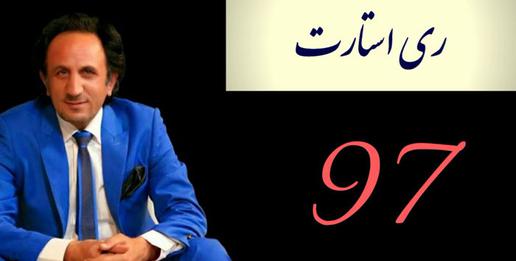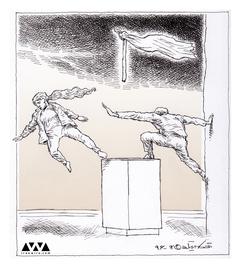A Telegram channel that was used to incite violence during recent nationwide protests is back in the news following deadly clashes between Gonabadi Sufis and security forces on February 19. The channel, Restart, is run by former gameshow host Mohammad Hosseini.
In recent days, Hojatoleslam Hasan Sadeghi, the Friday Prayers Leader in Gonabad, the city in northeastern Iran that Gonabadi dervishes get their name from, and Karimi Ghoddousi, a hardliner member of the parliament, have claimed there are links between the Sufis and the Restart channel, or at least to some of the channel’s followers.
Since the clashes, the Sufis have categorically denied that they are connected to any other group but the Gonabadi order. They believe recent attempts to portray them as violent enemies of the Islamic Republic — they have even been labeled “ISIS dervishes” — are laying the grounds for a renewed crackdown on Sufis.
Restart’s frontman Mohammad Hosseini describes the channel as a “movement.” He claims it has 30 million supporters who subscribe to a kind of mystic Sufi faith, and that he has chosen the name Restart to encourage them to think in new ways.
Certain actions carried out by the group, including attacks on government buildings, breaking windows and setting fire to buildings, have attracted huge attention, as has the fact that those responsible for these attacks have scrawled the word “Restart” on their targets. Hosseini has been broadcasting messages to the people of Iran on Telegram, Instagram and other social media platforms since March 2016, urging them to “#restartIran”— and he has expressed hopes his movement will earn the support of the US government.
“Burn them Down!”
"We started with a color protest," Hosseini told Bloomberg News. "We told people to spray colors on the walls of buildings that belonged to the [the paramilitary] Basij." After this, Hosseini said they moved on to urge Iranians to throw rocks at the windows of government buildings. "Then we said there should be a fire protest," he said. "They should burn down government mosques and police stations."
Hosseini regularly issues instructions to his supporters via the Restart channel and has announced that he wants to revive the empire of Cyrus the Great, or to create a Sufi empire — without making clear what the two have in common. In a recorded message during the December and January protests, he threatened the Revolutionary Guards and Basij forces. He said if they remained on the streets, his supporters would kill or set fire to 120 members of the Guards and their families.
Hosseini has no previous record of political activism. From 1994 to 2010, he worked with the Islamic Republic of Iran Broadcasting (IRIB) as the host of a gameshow called Simorgh. On the show, he asked contestants to perform silly stunts in exchange for prizes. After leaving Iran he continued to be involved in the production of satirical programs. Little by little he became a militant opponent of the Islamic Republic. He then launched Restart.
He claims that so far, his supporters have set fire to 30 mosques, between 500 and 600 banks, between 200 and 300 ATMs, and between 150 and 180 Basiji bases. These are more than likely exaggerations, but the fact that Mohammad Hosseini has been publicly inciting violence is what matters. He says he wanted the mosques to be set on fire because Basij forces have turned them into their bases, but he has not explained why his supporters set fire to banks or ATMs.
Destroy for a “Fundamental Renovation”
Hosseini calls his followers “Restarters.” I talked to one of them called Kurosh. He described Restart as a “belief system” derived from Sufism. “The Mullahs have totally destroyed Iran’s social, cultural, economic and political infrastructure,” he said, and now a “fundamental renovation” is unavoidable. “Everything has been destroyed, even if it appears to be all right,” he said. He also said he believes Restart will deliver the “deathblow” to a system that “has been emptied out by injustice and corruption.”
Alireza is another Restart supporter. But unlike Hosseini, he calls himself “a monarchist.” For him, Restart is not a belief system but a “tool” to “get over the rule by the mullahs.” He gave his explanation for the recent destruction instigated by groups of Restart followers: “Which is worse? Annihilation of many generations to end up as a primitive society like those of Iraq and Afghanistan, or destroying a few buses and banks so that we can be victorious in a few months’ time? The cost of such destruction does not come close to the cost of what the Islamic Republic wastes in a week.”
For him, Restart is part of a new revolution in Iran. “The revolution needs the Restart ideology to reach a point that the parliament becomes the decision-maker and the Shah is reinstated as a historical symbol. How much blood has been shed during other revolutions to achieve freedom and democracy? And you complain about a few destructive acts by the Restarters?”
In a short video [in Persian] posted on YouTube by Restart supporters, a man is holding a gun and boasting about it. “We might temporarily resort to using guns, as much as it was used during the 1979 [Islamic] Revolution,” said Alireza. “This revolution is an insurrection against tyranny.”
Some commentators have said that Restart is copying anarchist movements in some European countries. For example, Restart might be inspired by an anarchist movement that took shape in the suburbs of Paris a few years ago. Young people took to the streets to protest against unemployment and marginalization, leading to violence and unrest.
Anarchy Undermines Civil Movements
Kazem Kardavani, a political analyst who was once a student activist, told IranWire that Restart is very close to anarchism. And he believes that it can actually damage civil movements in Iran and give the Islamic Republic more leeway and power for oppression. “Anarchy undermines and discredit civil struggles,” he told me. “When a movement promotes violence and desperate young people join it out of ignorance, we do not know who is active in it. In political movements, we know who the activists are. In this case we do not know who they are; it is quite possible that the regime is pulling the strings.”
Kardavani points to similar groups that emerged after the 1905 Iranian Constitutional Revolution and during the premiership of the nationalist Mohammad Mosaddegh, who was overthrown in a CIA-engineered coup. “There are no control over groups that are active underground,” he said. “These groups are always open to infiltration by the regime’s security forces. That is one of the reasons that they are dangerous.”
He cites the comparison of “African Mafiosi” groups that use and exploit children to bolster their agenda. Although these groups often fade or vanish, the damage to the children is a more permanent problem. It’s not easy for them to return to a normal life after being a part of such a movement.
But, he said, the violent political context of Iranian society — both the violence among various strata in the society and the violence employed by the Islamic Republic — lays the ground for movements such as Restart. “You can see the violence in relations between individuals in Iran,” he said. “This kind of violence provides a breeding ground for uncontrolled, savage and anarchistic movements.”
Violence Leads to more Violence
“Another factor,” Kardavani said, “is the violence that the Islamic Republic has fomented through naked crackdowns, continuous arrests, prison ‘suicides,’ killing people and public executions. Naked violence leads to more naked violence.” In an apparent reference to Mohammad Hosseini, he added: “Now someone who no one knows where he comes from and does not even know how to talk is sitting on this powder keg.”
According to Kardavani, the way Iranian police have treated the country’s young people has led to “rage” and “frustration,” and yet these young people have no legitimate way to demand justice and retribution. “Anarchist movements in Europe had a clear political profile and specific goals,” he pointed out. “Their activists came from universities and eventually many of them joined civil movements and became media activists. Even when workers resorted to sabotage in England their movement had a known identity. But movements like Restart are born from hate toward the mullahs and from general violence in the society — without a clear identity and without clear goals. If this movement continues, the society will pay a high price, the regime will become more violent, and the most rabid hardliners will have an excuse to crack down harder.”
Rebels without a Cause
Ahmad Rafat is an Iranian-Italian journalist who has reported for many years on civil and anarchist movements in Europe. He recently interviewed young protesters in France. Like Kardavani, he believes that Restart is a “rebellious” movement, not a real political one. He says that young Restart activists are rebelling because they are hopeless and alienated. “European movements had political plans and goals,” he said, “whereas this group has no agenda and only talks about destruction.”
Rafat argues that Restart could alienate the middle class and lead people to lose trust in civil activist movements. “They might even be driven to cooperate with the police in cracking down,” he said. “If cars are damaged and ATMs are set on fire, people will, at least indirectly, cooperate with the crackdown by the regime.”
Rafat remembers his own experience in Italy in 1978. During anarchist riots, young people imitated the 1968 protests by going into shops and stealing from them. Police took action, and members of the middle class who until then had a more favorable view of the protests, applauded the police.
He believes that “bewilderment about the future” gives rise to movements like Restart. “In France the young people were saying, ‘we destroy everything so that maybe we can find our future in the rubble,’” he said, “but destroying is not the answer when you have no idea what you are going to build. What you want to build over the rubble is of paramount importance. Destroying without a plan for the future is a dangerous course of action, and the regime can exploit it for its own purposes as it has done in the last few years, instilling fear in people by telling them: ‘if we go, Iran will become another Syria or another Iraq.’” The result, Rafat said, is that the Islamic Republic can use violence to crack down on and destroy any protest.
This may be happening right now. The recent claims from hardliners about connections between the Sufis and the followers of Restart could be a prelude to more violence on behalf of the Islamic Republic, against dervishes or any other civil movement.
visit the accountability section
In this section of Iran Wire, you can contact the officials and launch your campaign for various problems

























comments